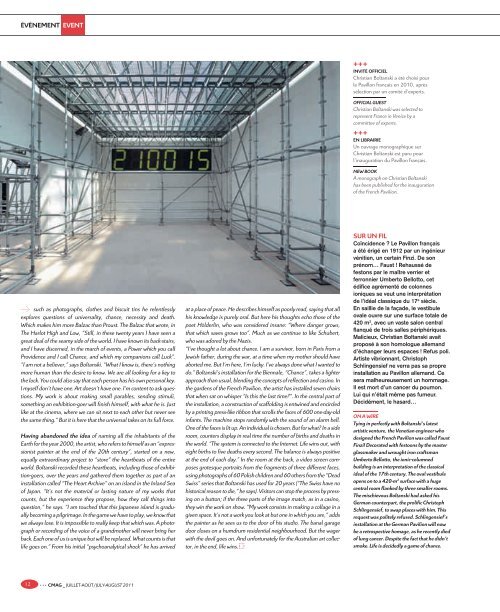NOCES VÉNITIENNES
NOCES VÉNITIENNES
NOCES VÉNITIENNES
Create successful ePaper yourself
Turn your PDF publications into a flip-book with our unique Google optimized e-Paper software.
ÉVÉNEMENT EVENT<br />
such as photographs, clothes and biscuit tins he relentlessly<br />
explores questions of universality, chance, necessity and death.<br />
Which makes him more Balzac than Proust. The Balzac that wrote, in<br />
The Harlot High and Low, “Still, in these twenty years I have seen a<br />
great deal of the seamy side of the world. I have known its back-stairs,<br />
and I have discerned, in the march of events, a Power which you call<br />
Providence and I call Chance, and which my companions call Luck”.<br />
“I am not a believer,” says Boltanski. “What I know is, there’s nothing<br />
more human than the desire to know. We are all looking for a key to<br />
the lock. You could also say that each person has his own personal key.<br />
I myself don’t have one. Art doesn’t have one. I’m content to ask questions.<br />
My work is about making small parables, sending stimuli,<br />
something an exhibition-goer will fi nish himself, with what he is. Just<br />
like at the cinema, where we can sit next to each other but never see<br />
the same thing.” But it is here that the universal takes on its full force.<br />
Having abandoned the idea of naming all the inhabitants of the<br />
Earth for the year 2000, the artist, who refers to himself as an “expressionist<br />
painter at the end of the 20th century”, started on a new,<br />
equally extraordinary project to “store” the heartbeats of the entire<br />
world. Boltanski recorded these heartbeats, including those of exhibition-goers,<br />
over the years and gathered them together as part of an<br />
installation called “The Heart Archive” on an island in the Inland Sea<br />
of Japan. “It’s not the material or lasting nature of my works that<br />
counts, but the experience they propose, how they call things into<br />
question,” he says. “I am touched that this Japanese island is gradually<br />
becoming a pilgrimage. In the game we have to play, we know that<br />
we always lose. It is impossible to really keep that which was. A photograph<br />
or recording of the voice of a grandmother will never bring her<br />
back. Each one of us is unique but will be replaced. What counts is that<br />
life goes on.” From his initial “psychoanalytical shock” he has arrived<br />
12 ... CMAG _ JUILLET-AOÛT/JULY-AUGUST 2011<br />
at a place of peace. He describes himself as poorly read, saying that all<br />
his knowledge is purely oral. But here his thoughts echo those of the<br />
poet Hölderlin, who was considered insane: “Where danger grows,<br />
that which saves grows too”. Much as we continue to like Schubert,<br />
who was adored by the Nazis.<br />
“I’ve thought a lot about chance. I am a survivor, born in Paris from a<br />
Jewish father, during the war, at a time when my mother should have<br />
aborted me. But I’m here, I’m lucky. I’ve always done what I wanted to<br />
do.” Boltanski’s installation for the Biennale, “Chance”, takes a lighter<br />
approach than usual, blending the concepts of refl ection and casino. In<br />
the gardens of the French Pavilion, the artist has installed seven chairs<br />
that when sat on whisper “Is this the last time?”. In the central part of<br />
the installation, a construction of scaffolding is entwined and encircled<br />
by a printing press-like ribbon that scrolls the faces of 600 one-day-old<br />
infants. The machine stops randomly with the sound of an alarm bell.<br />
One of the faces is lit up. An individual is chosen. But for what? In a side<br />
room, counters display in real time the number of births and deaths in<br />
the world. “The system is connected to the Internet. Life wins out, with<br />
eight births to fi ve deaths every second. The balance is always positive<br />
at the end of each day.” In the room at the back, a video screen composes<br />
grotesque portraits from the fragments of three different faces,<br />
using photographs of 60 Polish children and 60 others from the “Dead<br />
Swiss” series that Boltanski has used for 20 years (“The Swiss have no<br />
historical reason to die,” he says). Visitors can stop the process by pressing<br />
on a button; if the three parts of the image match, as in a casino,<br />
they win the work on show. “My work consists in making a collage in a<br />
given space. It’s not a work you look at but one in which you are,” adds<br />
the painter as he sees us to the door of his studio. The banal garage<br />
door closes on a humdrum residential neighbourhood. But the wager<br />
with the devil goes on. And unfortunately for the Australian art collector,<br />
in the end, life wins.<br />
+++<br />
INVITÉ OFFICIEL<br />
Christian Boltanski a été choisi pour<br />
le Pavillon français en 2010, après<br />
sélection par un comité d’experts.<br />
OFFICIAL GUEST<br />
Christian Boltanski was selected to<br />
represent France in Venice by a<br />
committee of experts.<br />
+++<br />
EN LIBRAIRIE<br />
Un ouvrage monographique sur<br />
Christian Boltanski est paru pour<br />
l’inauguration du Pavillon français.<br />
NEW BOOK<br />
A monograph on Christian Boltanski<br />
has been published for the inauguration<br />
of the French Pavilion.<br />
SUR UN FIL<br />
Coïncidence ? Le Pavillon français<br />
a été érigé en 1912 par un ingénieur<br />
vénitien, un certain Finzi. De son<br />
prénom… Faust ! Rehaussé de<br />
festons par le maître verrier et<br />
ferronnier Umberto Bellotto, cet<br />
édifi ce agrémenté de colonnes<br />
ioniques se veut une interprétation<br />
de l’idéal classique du 17 e siècle.<br />
En saillie de la façade, le vestibule<br />
ovale ouvre sur une surface totale de<br />
420 m 2 , avec un vaste salon central<br />
fl anqué de trois salles périphériques.<br />
Malicieux, Christian Boltanski avait<br />
proposé à son homologue allemand<br />
d’échanger leurs espaces ! Refus poli.<br />
Artiste vibrionnant, Christoph<br />
Schlingensief ne verra pas sa propre<br />
installation au Pavillon allemand. Ce<br />
sera malheureusement un hommage.<br />
Il est mort d’un cancer du poumon.<br />
Lui qui n’était même pas fumeur.<br />
Décidément, le hasard…<br />
ON A WIRE<br />
Tying in perfectly with Boltanski’s latest<br />
artistic venture, the Venetian engineer who<br />
designed the French Pavilion was called Faust<br />
Finzi! Decorated with festoons by the master<br />
glassmaker and wrought iron craftsman<br />
Umberto Bellotto, the ionic-columned<br />
building is an interpretation of the classical<br />
ideal of the 17th century. The oval vestibule<br />
opens on to a 420-m 2 surface with a huge<br />
central room fl anked by three smaller rooms.<br />
The mischievous Boltanski had asked his<br />
German counterpart, the prolifi c Christoph<br />
Schlingensief, to swap places with him. This<br />
request was politely refused. Schlingensief’s<br />
installation at the German Pavilion will now<br />
be a retrospective homage, as he recently died<br />
of lung cancer. Despite the fact that he didn’t<br />
smoke. Life is decidedly a game of chance.



